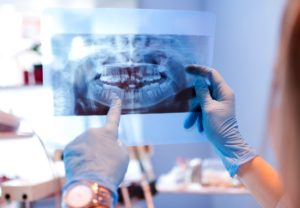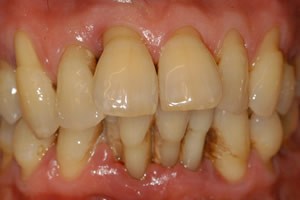Header logo
header top contact widget
Implant Placement
Are Dentures Or Partials Causing Your Face To ‘Melt’?
Posted on Feb 12, 2020 by William J. Claiborne, DDS MS
Occasionally, I’ll unexpectedly walk by a mirror and notice an old man looking at me, only to realize “that’s ME!”
As we age, hopefully most people don’t “feel” their actual age, although the person in the mirror isn’t quite the image we want to have. Most of us “see” ourselves as looking ten or so years yo unger (and probably 10 or so pounds lighter!).
unger (and probably 10 or so pounds lighter!).
Aging gracefully is a positive part of our lives. At any age, as long as we look and feel like we’ve taken pretty good care of ourselves, each birthday should cause more smiles than not. However, for people who are long-time denture or partial wearers, the signs and challenges of aging are more obvious.
Wearing a full denture or a partial denture appears, visually, to replace missing teeth. While the gum based that supports these replacement teeth “plumps up” the face when they are in place, this fullness can be deceiving.
What is really taking place – that you can’t see – is the loss of bone mass, or resorption.
Resorption describes a melting away of bone. For the upper or lower jaw, the areas where natural tooth roots no longer exist experience this almost immediately after they are removed.
Resorption occurs when tooth roots are no longer providing stimulation and nourishment to the bones that support them. This causes the bone “ridge” that holds the denture or partial to flatten out.
Bone loss begins almost immediately after teeth are removed. The pressure on the ridge while wearing dentures or partials actually accelerates the rate of bone loss. For people who sleep in their dentures, this increases the process even more.
In addition to appearance changes, bone loss is the reason that dentures slip or rub. This is because the denture was conformed to the ridge when it was first made. As the ridge flattens, the denture no longer ‘hugs’ the surface it was designed for.
As resorption continues, changes in facial appearance are occurring as wel. The best way to detect bone loss is to remove your ‘appliance’ and look in the mirror. However, even with the denture in place, certain facial changes may be obvious.
Jowls form on the sides of face as facial muscles detach from the declining bone mass. Deep wrinkles form around the lips and the corners of the mouth turn down, even in a smile.
As resorption worsens, the mouth seems to collapse into the face. The chin becomes more pointed and the nose and chin move closer together. This appearance is referred to as a “granny look,” aging one’s appearance far beyond their actual years.
How do you avoid a ‘melting face’?
One of the many advantages of dental implants is their ability to halt bone loss. The implanted portion restores stimulation to the jaw bone and provides a natural biting and chewing stability.
As a periodontist, an area of this advanced dental specialty is the diagnosis and placement of dental implants. Because there are many different types of implant systems, having a specialist select and place the one best for you will enhance your overall outcome.
In our Asheville periodontal office, we also offer oral and IV sedation (twilight sleep). These are administered by a board certified Anesthesiologist. This is a medical doctor (MD) who ensures safety and comfort are priorities throughout your procedure.
With dental implants, you can improve your appearance and health. Learn more about the lifelong benefits of dental implants by visiting our web site or calling 828-274-9440.
Osteoporosis Meds May Cause Permanent Damage To Jaw Bone
Posted on Jan 18, 2020 by William J. Claiborne, DDS MS
Many physicians who prescribe bisphosphonates for osteoporosis have relied on the drug makers’ stance of low risk for side effects. This has often left patients unfamiliar with the risks when they are scheduled for dental procedures.
Bisphosphonates include Fosamax, Actonel, Boniva, Reclast, Binosto, Prolia, Zometa and Xgeva. The most prescribed is Fosomax and ranks as one of the top 25 most prescribed drugs on the market.
The complication with bisphosphonates is a risk for jaw osteonecrosis. In simple terms, this is death of the jaw bone.
Jaw osteonecrosis occurs when the bone fails to heal after a surgery, even a minor procedure such as a tooth extraction. It results from obstruction of blood supply, which is caused by the drug’s potential interference with the bone’s ability to repair itself.
Common symptoms of jaw osteonecrosis are pain, swelling or infection of the gums and jaw, gums that don’t heal, and loose teeth. However, its onset can also occur without obvious symptoms.
In addition to treating osteoporosis, bisphosphonates are used to treat cancer that has spread to the bone. In these cases, bisphosphonates are given intravenously and in higher doses. This creates an even greater risk of osteonecrosis of the jaw than for individuals on oral doses.
Jaw osteonecrosis risk seems to increase with the amount of time biphosphonates are taken. However, researchers have determined that bisphosphonates can create a risk for necrosis with even short-term use of the oral medications for osteoporosis.
The most commonly prescribed bisphosphonate, Fosamax, was approved by the FDA in 1995. By 2003, reports began surfacing that linked bisphosphonates with jaw osteonecrosis.
In a study of over 200 participants who took Fosamax for varying durations, 4 percent acquired osteonecrosis. This finding was in contrast to the drug makers’ claims that bisphosphonate use only posed a noticeable risk for those who took the medication intravenously, such as cancer patients.
Not only did the study show that short-term usage can place the patient at risk, the drug can maintain a 10-year half-life in bone tissue. The risk for jaw necrosis is highest with procedures that directly expose the jaw bone, such as tooth extractions and dental implant placement.
Many people are often surprised by the wide range of medications that affect their oral health. For example, Coumadin, a commonly prescribed blood thinner, can cause more bleeding during certain procedures.
Antidepressants and high blood pressure medications can cause elevated levels of plaque and signs of gingivitis. Too, gingival enlargement, a condition that causes the gums to swell and grow over teeth, can lead to severe periodontal infection. Calcium channel blockers used to control high blood pressure can also contribute to this gum tissue overgrowth.
Many cough drops, medications in syrup form and antacids contain sugars that often leave a sticky residue on teeth, making them more susceptible to decay. Certain antibiotics and ibuprofen can cause lesions or ulcers in the mouth.
Oral contraceptives and blood pressure medications have been linked to mouth sores and inflammation. Tetracycline, typically used for treating acne, can discolor teeth as well as supporting bone.
While you may assume that herbal supplements don’t apply, they can actually have serious side effects for some dental patients. For example, Ginkgo Biloba and Vitamin E can act as blood thinners. When combined with aspirin, the combination may cause difficulties in blood clotting. For patients undergoing surgical procedures, this can be a serious problem.
Taking high dosages of vitamins before undergoing anesthesia can also put you at risk. For instance, high doses of Vitamin C can weaken the efficiency of anesthesia. On the flip side, supplements such as Kava Kava or St. John’s Wort can accentuate anesthesia’s effectiveness.
This is why it is important to make us aware of all the drugs you take, including over-the-counter supplements. The goal is to provide a successful outcome for each periodontal procedure or dental implant placement. Being familiar with your overall health enhances the potential for positive oral health.
If you have questions regarding the medications you are taking in regard to oral risks, call our Asheville periodontal office at 828-274-9440 prior to your appointment. And, at each visit, keep us updated on your medications.
The Value Of Dental Implants Goes On & On.
Posted on Jan 08, 2020 by William J. Claiborne, DDS MS
Many people have a list of favorite holiday movies. One that stand out for me is “Christmas Vacation,” where Clark Griswold attempts to create the perfect Christmas for a hoard of family members who have descended upon his home.
In the movie, Clark learns that, instead of his company’s annual Christmas bonus, he’s received a certificate for “Jelly of the Month” club. Cousin Eddie famously comments, “It’s the gift that keeps on giving.”
Laughs aside, this always reminds me of how much we spend, all year long, on things that really add very little to our lives. People invest in new cars, clothes, jewelry, and fancy electronics – many purchases based on ads indicating these items will bring us great pleasure.
Yet, year after year, Americans struggle to pay January credit card bills laden with holiday purchases. And, we begin a new year not as fulfilled as we thought. I’d like to make a suggestion: your smile!
Is there anything that would give you as much pleasure as a healthy, confident smile?
Life’s best moments are things like laughing with close friends, dining out in our favorite restaurant, close conversations with loved ones, and the bite of a red apple picked right off the tree.
As a Periodontist, I see how difficult life can be for patients with dentures and partial dentures. To witness the transformation of an individual who has replaced “slippery” dentures with dental implants has been a particular joy throughout my career.
Over the past three decades, there have been remarkable advancements in implant dentistry. It has easily become the preferred replacement for missing, natural teeth. Today, there are implant types that offer exceptional choices to fulfill nearly any need when it comes to replacing teeth with dependable stability and a natural look and feel.
While I share the excitement of our implant patients when they “see” their appealing, confident smiles after treatment completion, as a periodontist, I know it is the foundation beneath the gums that is the true benefit of dental implants.
Like natural teeth, implants are held by the upper or lower jaws. The jaw bones actually thrive on the presence of tooth roots for stimulation to keep the bone healthy. Without tooth roots, the bone goes through a process known as resorption. Resorption causes bones to lose height and width, almost like they are melting.
Dental implants are able to mimic the stimulation they need to prevent the process of resorption.
Bone loss contributes to a number of problems. Once resorption sets in, the teeth adjacent to the area of bone loss are affected. Bone loss that neighbors areas of resorption weakens tooth root stability. When a natural tooth is lost, statistics show the next to be lost will most likely be an adjacent tooth.
Bone loss can even be seen in some people. It causes the appearance of a collapsed mouth (referred to as a “granny look”) where the nose is unusually close to the chin. It is also the reason that dentures and partials begin to move or “slip.” This can cause uncomfortable rubbing on gum tissues.
When a denture is first made, it is shaped to fit the unique contours of your gum ridge (the gum-covered arch that once held your natural tooth roots). As bone loss continues, the once-secure fit loosens and cause sore spots on tender gum tissues while chewing. Denture pastes or adhesives can help, but eventually even relines are of little help.
For many, another appealing advantage of dental implants is that they are a lifelong investment. Dental implants, properly selected and placed, are designed to last a lifetime with proper maintenance.
Adults are also seeing dental implants as a wiser option than crown-&-bridge combinations. Unlike dental implants, crowns and bridges can require repairs or replacements over time. Too, crowning natural teeth for the sole purpose of supporting a bridge forever compromises the health of otherwise natural teeth.
Dental implants do not rely on adjacent teeth for support since they are anchored in the jaw bone. This restores the same, sturdy foundation as natural tooth roots. An added bonus is how the implanted portion recreates the presence of a tooth root, halting the process of resorption.
If you are missing natural teeth, consider the advanced skills of a periodontist to consult with on dental implants. For a private, no obligation consultation to discuss your specific goals or concerns, call 828-274-9440 for an appointment.
If fear of dentistry is an obstacle for you, we can also discuss our sedation options. Our office is known for providing respectful, gentle care and oral and IV sedation are available as needed, administered safely and to the highest standards. Feel free to mention your concerns during your consultation.
A Periodontal Specialist Explained
Posted on Dec 13, 2019 by William J. Claiborne, DDS MS
Occasionally, I meet someone new who is unfamiliar with my specialty. Although a periodontist may seems to be a “behind the scenes” specialist, our focus actually has an upfront role in your oral health, and beyond.
A periodontist is a dentist who specializes in the prevention, diagnosis, and treatment of periodontal disease, and in the placement of dental implants. Periodontists are also experts in the treatment of oral inflammation. Periodontists receive extensive training in these areas, including three additional years of education beyond dental school.
In addition to having advanced training in the latest techniques for diagnosing and treating periodontal disease, a periodontal specialist is also trained in performing cosmetic procedures that involve gum tissues, such as correcting a “gummy smile”.
Periodontists often treat more problematic periodontal cases, such as people with severe gum disease or have a complex medical history. A periodontist offers a wide range of treatments, such as scaling and root planing (cleaning the infected surface of the root) or root surface debridement (removing damaged gum tissue).
Periodontal specialists can also treat patients with severe gum problems using a range of surgical procedures.
In addition, periodontists are specially trained in the placement, maintenance, and repair of dental implants.
During the initial appointment in our Asheville periodontal office, we typically begin with a review of the patient’s medical and dental histories. This information is important so we are aware of medications being taken or if the patient is being treated for any condition that can affect periodontal care, such as heart disease, diabetes, or pregnancy.
During the examination, we check the patient’s gums to look for gum line recession. We will also assess how the teeth fit together when biting, and check for any loose teeth. An important part of this exam is in the measuring of spaces between gum tissues at the base of teeth.
Using an instrument called a probe that is gently positioned between specific points surrounding each tooth, we determine the depth of periodontal “pockets”. These measurements help us assess the health of your gums. Images (x-rays) may also be taken to revealsthe health of the bone below the gum line.
Periodontal disease, also referred to as “gum disease,” often exists without an individual being aware of its presence. In its early stage, gingivitis, some people even assume that symptoms, such as seeing blood in the sink when brushing, are normal.
Obvious symptoms, such as pain, may not appear until the disease has reached an advanced stage. This is why it is important to be familiar with the signs and symptoms, which include:
• Red, swollen or tender gums or other pain in your mouth
• Bleeding while brushing, flossing, or when eating certain foods
• Gums that are receding (pulling away from the teeth) or make the appear teeth longer than normal
• Loose or separating teeth
• Pus between your gums and teeth
• Sores in your mouth
• Persistent bad breath
• A change in the way your teeth fit together when you bite
• A change in the fit of partial dentures
If you notice any of these symptoms, be sure to contact your dentist or periodontist without delay. Gum disease will only worsen without treatment.
Who Should See a Periodontist?
Some patients’ periodontal needs can be managed by their general dentist. However, patients who are experiencing signs and symptoms of moderate or severe levels of gum disease or have more complex cases receive the most efficient and effective care through team treatment between a general dentist and periodontist.
Restoring your gums to a healthy state is important! As research continually shows, gum health is intricately connected to overall health. Oral bacteria of periodontal disease has been linked as a trigger for more and more chronic diseases, including heart disease, some cancers, stroke, memory loss, diabetes, and arthritis. Having prompt periodontal treatment by a trained periodontal specialist may lower the risk for more serious, and even deadly, diseases and health conditions.
If you are experiencing any of the symptoms associated with periodontal disease, a referral is not required. Call 828-274-9440 and we will be happy to assist you.
If you do not have a general dentist, we can also refer some who are near to you and we know to provide gentle, thorough and appropriate care for their patients’ needs.
Recent Posts
Categories
Archives
- September 2024
- August 2024
- July 2024
- June 2024
- May 2024
- April 2024
- March 2024
- February 2024
- January 2024
- December 2023
- November 2023
- October 2023
- September 2023
- August 2023
- July 2023
- June 2023
- May 2023
- April 2023
- March 2023
- February 2023
- January 2023
- December 2022
- November 2022
- October 2022
- September 2022
- August 2022
- July 2022
- June 2022
- May 2022
- April 2022
- March 2022
- February 2022
- January 2022
- December 2021
- November 2021
- October 2021
- September 2021
- August 2021
- July 2021
- June 2021
- May 2021
- April 2021
- March 2021
- February 2021
- January 2021
- December 2020
- November 2020
- October 2020
- September 2020
- August 2020
- July 2020
- June 2020
- May 2020
- April 2020
- March 2020
- February 2020
- January 2020
- December 2019
- November 2019
- October 2019
- September 2019
- August 2019
- July 2019
- June 2019
- May 2019
- April 2019
- March 2019
- February 2019
- January 2019
- December 2018
- November 2018
- October 2018
- September 2018
- August 2018
- July 2018
- June 2018
- May 2018
- April 2018
- March 2018
- February 2018
- January 2018
- December 2017
- November 2017
- October 2017
- September 2017
- August 2017
- July 2017
- June 2017
- May 2017
- April 2017
- March 2017
- February 2017
- January 2017
- December 2016
- November 2016
- October 2016
- September 2016
- August 2016
- July 2016
- June 2016
- May 2016
- April 2016
- March 2016
- February 2016
- January 2016
- December 2015
- November 2015
- October 2015
- September 2015
- August 2015
- July 2015
- June 2015
- May 2015
- April 2015
- March 2015
- February 2015
- January 2015
- December 2014
- November 2014
- October 2014
- September 2014
- August 2014
- July 2014
- June 2014
- May 2014
- April 2014
- March 2014
- February 2014
- January 2014
- December 2013
- November 2013
- October 2013
- September 2013
- August 2013
- July 2013
- June 2013
- May 2013
- April 2013
- March 2013
- February 2013
- January 2013
- December 2012
- November 2012
- October 2012
- September 2012
- August 2012
- July 2012
- June 2012


